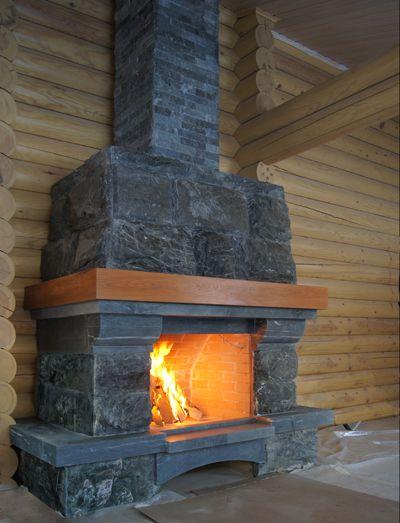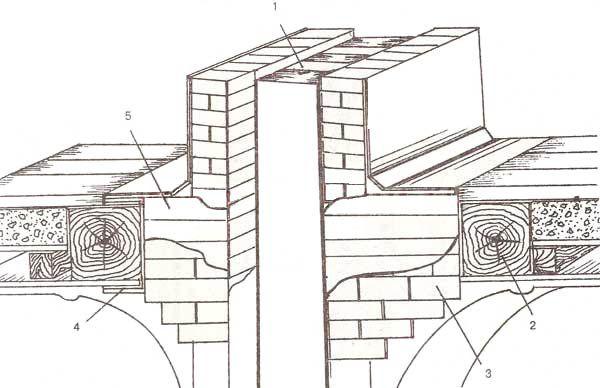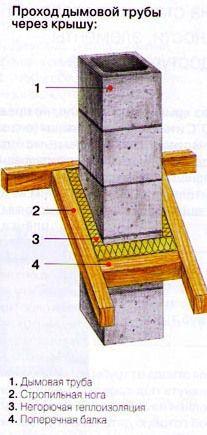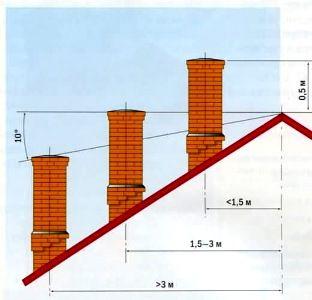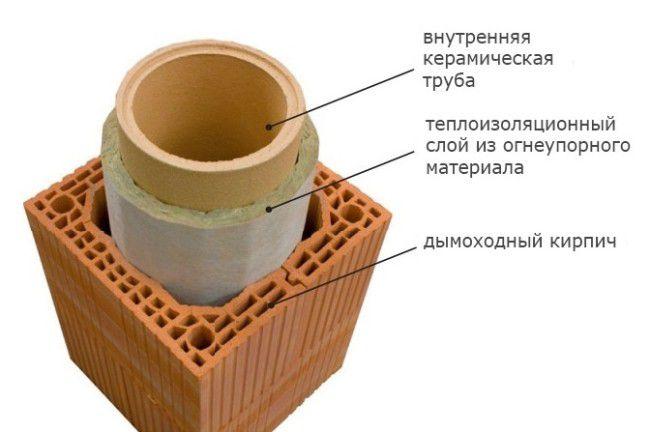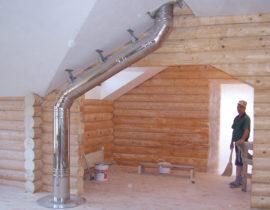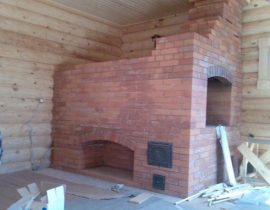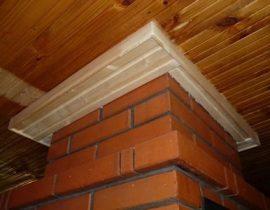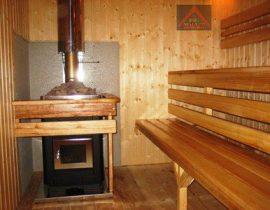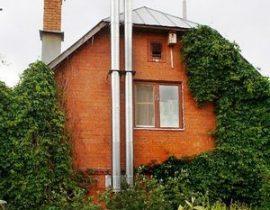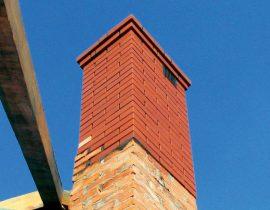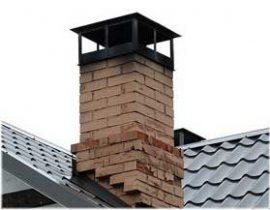A very serious and responsible event will be the installation of a chimney in a wooden house. The reason for this is the high temperature of the combustion products formed in the furnaces. Wooden surfaces at 200 degrees already begin to char, and when wooden structures are heated to 300 degrees, a fire is inevitable. The temperature of the combustion products entering the chimney can reach 500 degrees, and in some cases an open fire can also be observed in it. Thus, insufficient insulation of chimneys from wooden structures can lead to tragic consequences.
Content
What you need to know about the rules for installing a chimney in a wooden house?
The constant temperature of the combustion products in the smoke devices of heating systems may differ depending on the design, on the design of the chimney system and as it moves away from the place of combustion. From the table below, you can find out what is the temperature of the combustion products in certain heaters.
Wooden houses have been used by mankind for many years. Of course, during this time a certain set of rules has been developed, which concentrated the experience of building stove heating systems in such dwellings. In our country, building experience in this area is collected in SNiP 41-01-2003 "Heating, ventilation and air conditioning".
We will try to explain to you in detail the essence of the information contained in this document.
Requirements for the arrangement of chimneys
In order to prevent the occurrence of ignition of wooden building structures - chimneys in a wooden house must be located at a certain distance from elements of flammable materials:
- If the chimney pipe is made of ceramic material, which does not have thermal insulation, the minimum distance should be 25 centimeters,
- In the event that the chimney is made of concrete or brick, then the distance can be reduced to 15 centimeters.
Please note that not only wooden structures can ignite easily, but also many finishing materials made from synthetic materials. So, vapor barrier films are dangerous.
Brick chimney in a wooden house
The traditional material for making chimneys in wooden houses is refractory bricks. When laying chimneys, special attention must be paid to the bonding of bricks to each other. To connect the elements of a brick chimney in the interior of the house, a mixture of cement and limestone can be used, but when laying bricks in the chimney in the open space, pure cement mortar should be used.The thickness of the seam between the bricks in such a masonry should not exceed one centimeter. The brick should be red and not hollow.
The inner surface of a brick chimney is exposed to the aggressive effects of combustion products, condensate. As a result, chips and collapses can occur on the internal surfaces. To avoid such negative moments, an asbestos-cement pipe is placed inside the brick chimney, and the space between the brick and the pipe is filled with concrete mortar. Thus, you will carry out the so-called "sleeve" of the chimney.
The passage of the chimney through the wooden ceiling
The figure in the article shows how you can lead the chimney through a wooden ceiling.
You can use asbestos layers when passing through the floor. In this case, the distance between the pipe and the floor tree will be 25 centimeters.
In the event that an asbestos gasket is not used, then the distance between the pipe and the tree will have to be increased to 38 centimeters.
Connecting chimneys to wooden walls
As well as when passing through the ceiling - when adjoining wooden walls - the chimney pipes must be reliably thermally insulated.
The standards here are the same as when passing through the ceiling: 25 centimeters when using two layers of asbestos gasket and 38 centimeters without a gasket.
The entire structure can be laid on the sides with brickwork.
If you are installing a chimney in a new, not yet settled log house, then it is better to place it on a wooden shield that can move relative to the wall.In this case, the subsidence of the log house over time will not cause the destruction of the brickwork of the chimney and pipe.
The passage of the chimney through the roof of a wooden house
When removing the chimney through the roof, the distance between its heating elements and the rafters should not be less than 13 centimeters. In the gap between the pipe and the rafter tree, it is necessary to lay a heat insulator. In its quality, basalt wool can be used. When choosing wool for thermal insulation, make sure that it does not contain organic binders and that it is resistant to high temperatures.
If materials with a low ignition threshold are used as a roof on the roof, for example, sheet roofing material, then the distance to it should not be less than 25 centimeters. The space between the combustible material and the chimney pipe must be covered with a fireproof roof. Slate can serve as such a protective material. It will not transfer heat from the pipe to the roofing felt. Roofing steel can also be used as a protective coating.
The location of the chimney on the roof of a wooden building
The head of the chimney on the roof of a wooden building must rise above it to a height of at least 20 centimeters from the top of the ridge if the pipe is located directly next to the ridge or simply on a flat roof.
If the chimney pipe is less than one and a half meters from the ridge, then its height should also not be less than 50 centimeters.
If the chimney is located at a distance of one and a half to three meters from the ridge, then its head should not be below the level of the ridge.
In the event that your chimney is more than three meters from the ridge, then to calculate the height of the pipe head, you must draw an imaginary line directed from the roof ridge with a decrease of 10 degrees.
Ceramic chimneys for wooden buildings
Modern industry produces high-strength and fireproof modular chimneys from high-quality ceramic materials. They are a kind of constructs, which is assembled locally from several elements.
Such a chimney may consist of a multilayer material. Its inner surface is made of ceramic material, which is particularly resistant to heat and acids formed during the reactions of combustion products. Their inner surface is very smooth, which prevents the formation of soot and creates a smooth and powerful traction. But such a chimney system has considerable weight and requires special skill during installation.
Metal chimneys for wooden buildings
In addition to the usual metal pipes for chimneys, usually made of stainless steel or cast iron, the so-called “sandwich pipes”, which are a multilayer composition, have recently become popular.
The inner surface of such chimneys is made of stainless steel, then comes the insulating material - and then the galvanized pipe. Together, this complex performs its functions quite successfully and is very easy to assemble. The smooth stainless steel surface inside gives even traction, preventing the formation of turbulence.
However, when choosing such a pipe, it is very important to remember that different heating devices have different combustion temperatures and, based on this, choose the required thickness of the inner wall. When building a chimney for a gas, diesel or pellet boiler, it must be at least half a millimeter. Chimneys for saunas or fireplaces are usually equipped with an inner pipe of 0.8-1.0 mm, but for coal-fired stoves, this figure should be at least a millimeter.
Just like ceramic chimneys, sandwich chimney chimneys have a modular design and are easily connected to each other. So, special elements are produced for passing through interfloor ceilings. But even in this case, it is necessary to ensure that the pipe joint is not in the thickness of the ceiling.
Chimney device in a wooden house: instructional video:

